Top Ten Iranian Souvenirs
What are the top ten souvenirs of Iran among foreign tourists?
Among all the items and souvenirs one can acquire in Iran, some stand out. They are known globally and anyone in the world recognizes them as Iran’s.
These include Iranian carpets, Iranian Saffron, Pistachios, and so on. Another category of very popular souvenirs of Iran is handicrafts that are unique to each town and made with dexterity and love.
For example, Kilims. Moreover, the sweets and trail mix that Iranians prepare are very popular among visitors. Some tourists visit Iran excited to taste and buy Sohan or Gaz. They might specifically travel to Mashhad to purchase Saffron, the best quality money can buy.
There are many types and sorts of souvenirs you can buy from Iran, but in this article let us look at the top ten most popular items one can purchase in Iran.
Loom-Woven Items
These items of handicraft are prepared on looms, such as carpets, kilims, jajims, et cetera. Carpets and mats that originate in Iran are extremely popular in many countries of the world, due to the intricate design and the colorful illustrations that Iranians are wont to produce.
Many tourists buy a small piece of carpet, kilim, gabbeh, or jajim as memorabilia. It is clear that if you purchase an Iranian carpet or rug, you have bought the most valuable souvenir.
However, these carpets are usually very costly. If you rather not buy something so expensive and large, perhaps you would prefer a smaller, more economic souvenir such as a small kilim or jajim. Foreign visitors of this land often buy smaller mats that they can fit inside their suitcase.
In different areas of Iran, distinct colors, designs, and illustrations are common that have developed over generations of practice. We recommend taking your time browsing the vast selections and choosing something that fits your taste.
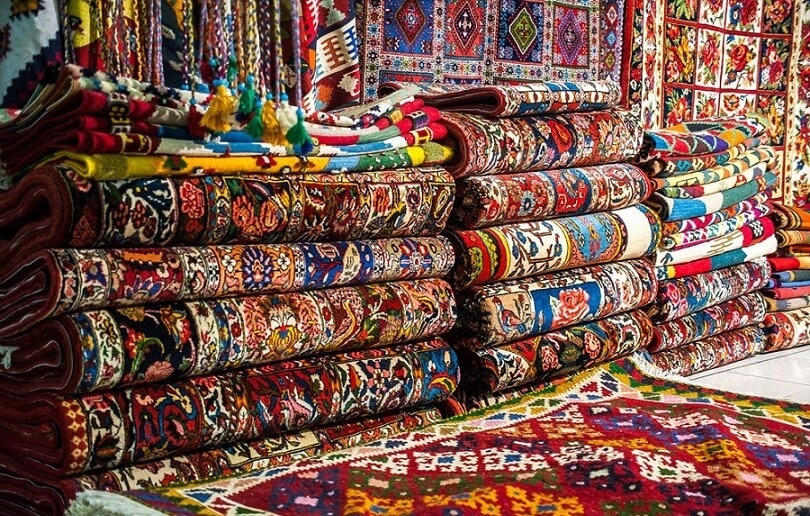
Loom-Woven Items
Traditionally-Made Cloths (Termeh, Ghalam-kar, and Pateh-doozi)
Some regions of Iran are famed for the quality and beauty of their hand-woven clothes. There can be a variety of types of decoration that people of a region use to embellish their handicrafts.
These include Termeh, Kalam-Kar (Ghalamkar or Qalamkaar), and Pateh-Doozi. Isfahan’s Kalam Kar cloths, known for their geometric and floral designs are some of the most well-known items of handicraft one can purchase from this city.
Yazd’s Termeh, used for making purses, table cloths, jewelry boxes, and even shoes, comprises this city’s most beloved handcrafted souvenir.
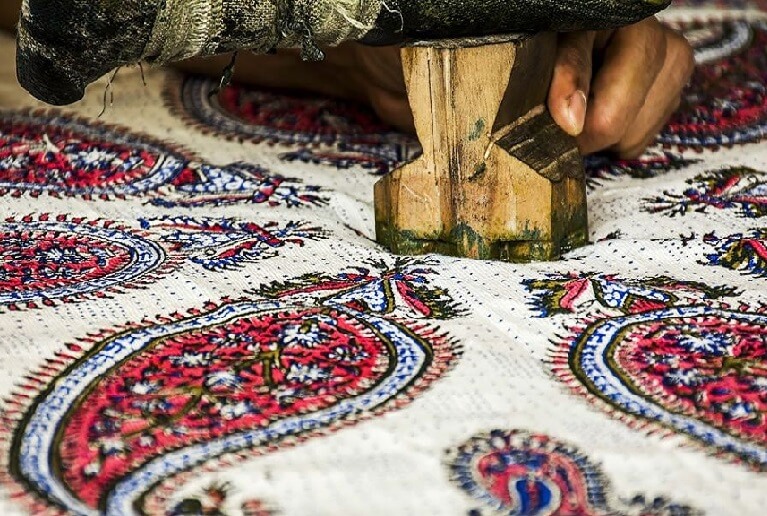
Traditionally-Made Cloths (Termeh, Ghalam-kar, and Pateh-doozi)
Giveh
Giveh is a traditionally-made Iranian footwear that originates in the mountainous areas of Zagros, including in Kermanshah.
The highest quality of this type of shoe is made with a leather sole and woven wool at the top. Because of their seams, they’re cool and suitable for use during the summer; hence their popularity among the rural population of Zagros.
Thankfully, the young artists of the west of the land have taken the matter into their own hands and designed modernized versions of Giveh to bring the attention of the people back to this traditional handicraft. Tourists, of course, rarely buy Giveh to actually wear them.
They purchase these items to use as decoration.
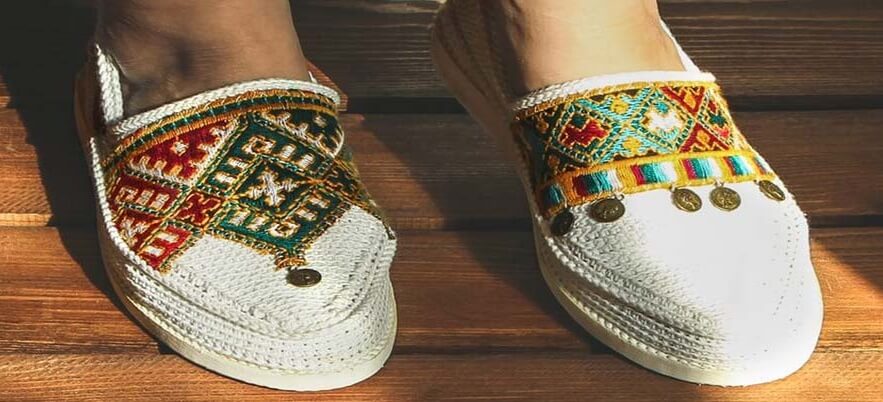
Giveh
Khatam Kari
Watching a master produce an artwork of Khatam Kari will prove quite a mesmerizing experience. Khatam Kari is one of the most famed wooden handicrafts of Iran.
Khatam Kari experts utilize wood, metal, and bone, to produce beautiful items such as jewel boxes, photo frames, and backgammon sets.
These are well-liked souvenirs and memorabilia among tourists. Naqsh-e Jahan Square and Vakil Bazaar are the places to go if you intend to purchase a piece of this art.
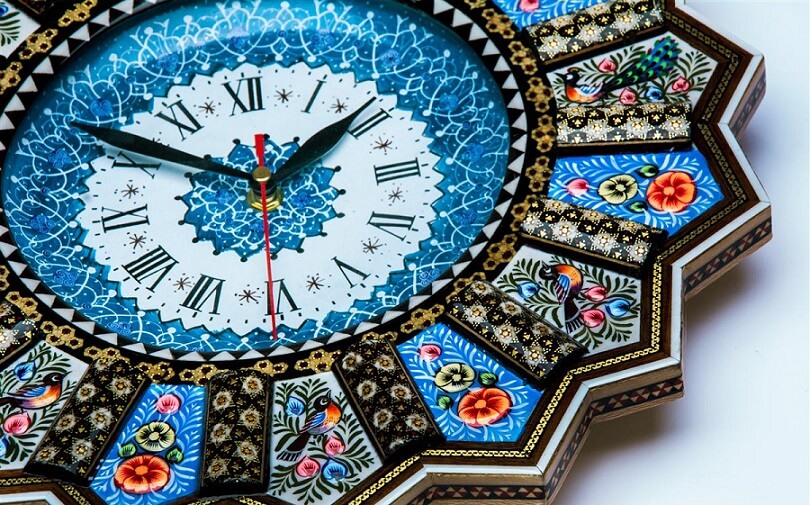
Khatam Kari
Mina Kari
It is easy to realize why they call Isfahan “Half of the World” once you set foot in this ancient city. No wonder that the most admired of Iran’s souvenirs originate from this area.
One of the most beloved souvenirs of Iran, and particularly Isfahan, is Mina Kari. Mina Kari works are copper bowls whose surface has been intricately embellished with miniature flowers or birds.
This artwork is often in the color blue, though you may also come across bowls in colors green and red. In Isfahan’s bazaar, or in other places all around Iran, the flowerpots, plates, vases, and other beautiful Mina Kari artworks are available for purchase.

Mina Kari
Pottery
The art of pottery in Iran goes way back. Due to its antiquity, the artwork has a lot of fanatics who buy them for gifting or memorabilia.
The pottery works of Lalejin in Hamedan, Natanz, and Meybod, produce the most popular works of art for this handicraft. A visit to the National Museum of Iran can inform you of the rich history of pottery in Iran’s antiquity that date back further than Persia’s Empire.
These days, Iranians exhibit this art in their hand-illustrated mugs and bowls. You could purchase one of these items and remember Iran each time you take a sip of coffee or tea.
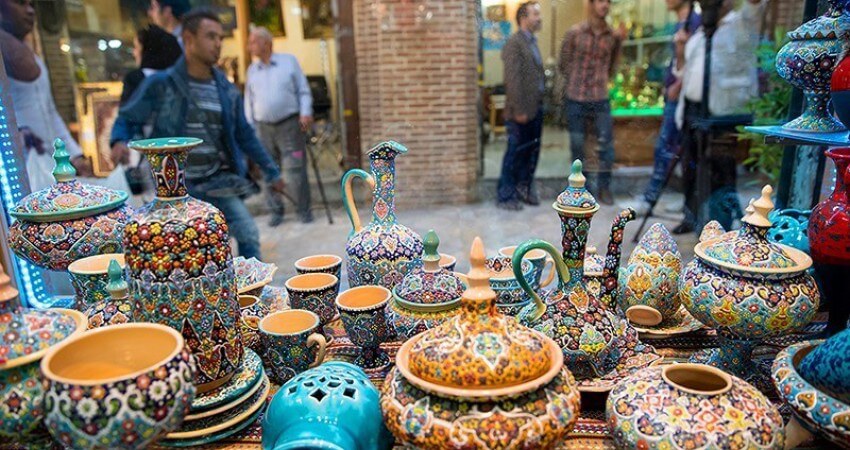
Pottery
Firoozeh Koobi (Turquoise Inlaying) of Neyshabur
Firoozeh is a valuable gemstone that is native to only certain regions of the world, namely, Iran. The epithet “Firoozeh” and the color Firoozeh-ee (Turquoise, in English) also originate from this root.
Interestingly, painters of old required turquoise powder to prepare their paint in this color, which was rare and precious.
The city of Neyshabur in the northeast of Iran is famed all around the world not only for being the birthplace of the polymath Omar Khayyam, but also for being the source of much of the most precious turquoise stones in the world.
The Turquoise of Neyshabur is one of the most popular turquoises in the world. It is often put into jewelry, but also inlay into copper bowls (the art of Firoozeh Koobi) to produce an admired artwork and souvenir.
If you prefer to buy an uncut Firoozeh gemstone, you must pay a visit to Firoozeh shops of Neyshabur or Mashhad; and for beautifully cut or inlayed Firoozeh, you can visit any Firoozeh shop in the capital or anywhere else in the country.
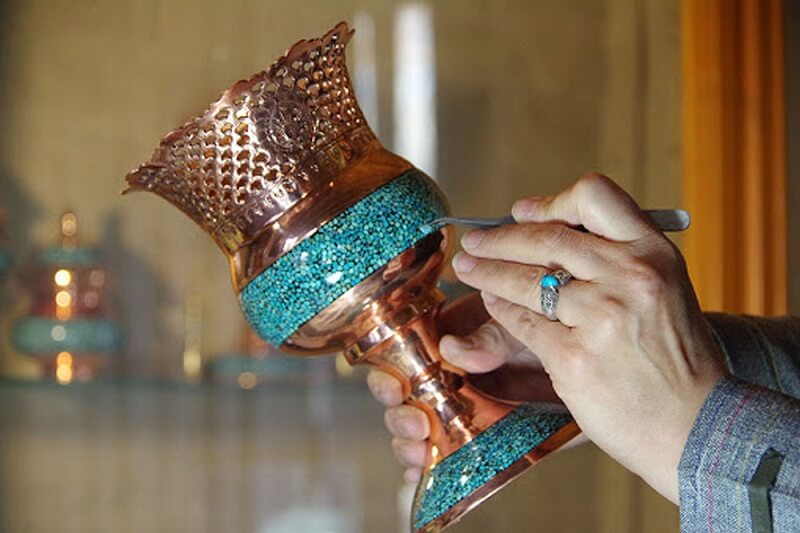
Firoozeh Koobi
Trail Mix, and Pistachios
Among edible souvenirs of Iran, nuts such as pistachios, almonds, walnuts, etc are popular. But the most famed are the pistachios of Kerman, Damghan, and Sabzevar.
Also, the extensive cultivation of dates has made this sweet produce a highly imported, frequently bought item.
Sometimes, Iran’s pistachios are referred to as the Green Gold of Iran. The pistachios packaged for tourists to purchase as souvenirs often come in high-end boxes and have guaranteed quality.
The time of the harvest of pistachios is Shahrivar and the beginning of Mehr (which coincides with September) during which you can purchase fresh green pistachios.
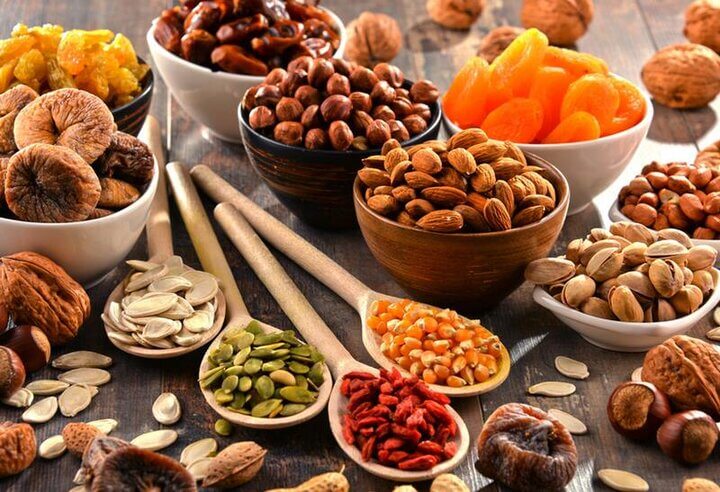
Trail Mix, and Pistachios
Spices (especially Saffron, the Red Gold of Iran)
All Iran’s popular spices are made from herbs and natural products and contain fiber, antioxidants, and vitamins. The spices include: pennyroyal, Persian Thyme, Saffron, Rosemary, Anise, Turmeric, Persian Cumin, Green Cumin, Coriander, and Tarragon. Among those named, of course, Saffron is the most well-known.
Saffron is called the Red Gold of Iran because of its global popularity and high demand. The cultivation of this spice is common in Khorasan Province of Iran and one of the most interesting tours of Iran for tourists, is to visit a Saffron farm and farmstead at the time of harvest.
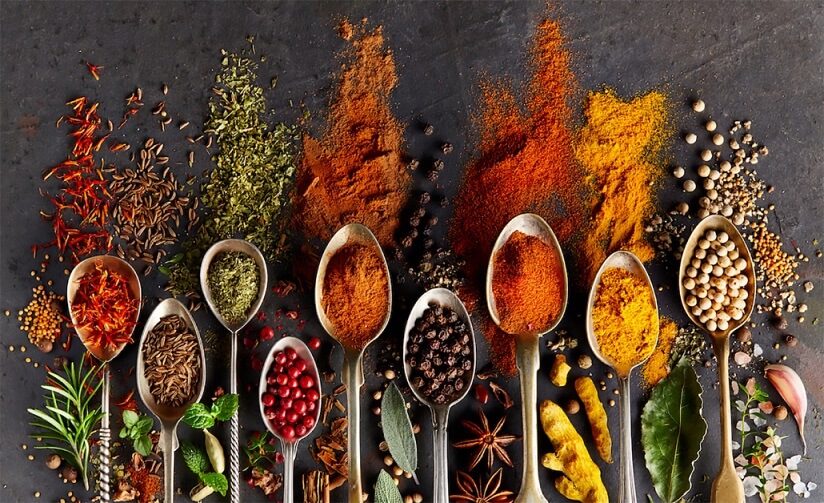
Spices (especially Saffron, the Red Gold of Iran)
Gaz and Sohan
Gaz and Sohan that are prepared in Isfahan have a lot of fanatics from Iran and other countries. Normal Gaz or Gaz that is rolled in flour (Gaz-e Awrdi) of the highest quality are available for purchase in Naqsh-e Jahan Square.
Gaz is also popularly prepared and sold in other cities like Qom, Yazd, and Kerman and is available to buy almost anywhere in the country.
There is a type of sweet named Sohan that is also commonly prepared and sold in Isfahan. Sohan is a type of Halwaa whose main ingredient is wheat sprout.
Sohan is an Iranian sweet made with sugar, almond flakes, Saffron, and butter that comes in many shapes and types, including Sohan Asali (asal means honey, therefore Sohan Asali is the type of Sohan with honey in it).
Qom is another city famed for its Sohans which are mostly filled with pistachios inside.
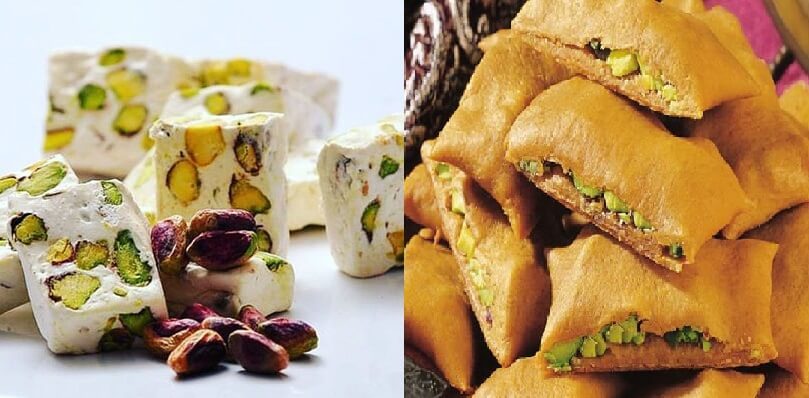
Gaz and Sohan


